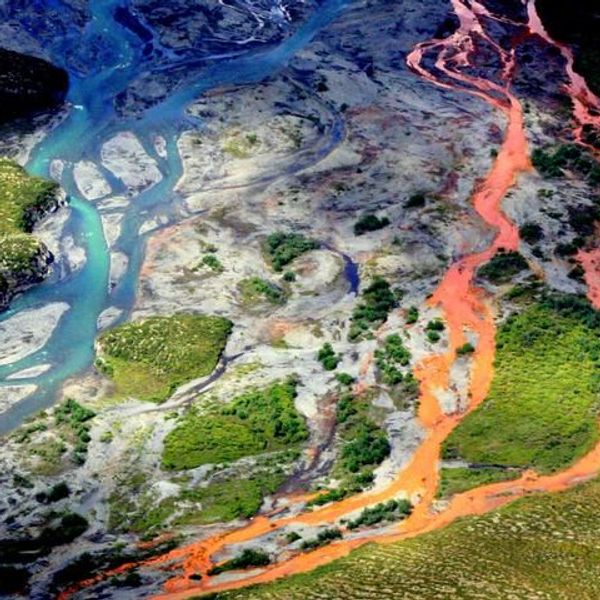Rising Sea Level Threat: Glaciers 'Beyond the Point of No Return'
Pair of studies out Monday foresees "collapse" in West Antarctica
Glaciers in the West Antarctic "have passed the point of no return," threatening greater sea level rise impacts than previously thought, scientists at NASA and the University of California, Irvine warning in a new study.
The findings, which focus on the Amundsen Sea sector of West Antarctica, were published in the journal Geophysical Research Letters.
The glaciers' grounding lines -- the points at least one thousand feet below ice where they first lose contact with land -- are moving further inland, and as that happens, the glaciers' flow speeds accelerate. And the faster they flow, the more they thin-- that means their days are likely numbered.
Only one of the six glaciers they studied, the Haynes Glacier, had an obstruction upstream to slow down these changes, but even its retreat is moving as quickly as the others, the scientists found.
Given these changes, glaciologist and lead author Eric Rignot, of UC Irvine and NASA's Jet Propulsion Laboratory in Pasadena, California, stated, "The collapse of this sector of West Antarctica appears to be unstoppable."
"The fact that the retreat is happening simultaneously over a large sector suggests it was triggered by a common cause, such as an increase in the amount of ocean heat beneath the floating sections of the glaciers. At this point, the end of this sector appears to be inevitable," he warned, adding that "a conservative estimate is it could take several centuries for all of the ice to flow into the sea."
A similar study by researchers at the University of Washington and published in Science found that the Thwaites Glacier, one of the six glaciers also studied in Rignot's research, is heading towards what might be inevitable collapse.
"All of our simulations show it will retreat at less than a millimeter of sea level rise per year for a couple of hundred years, and then, boom, it just starts to really go," lead author Ian Joughin, a glaciologist at the UW's Applied Physics Laboratory, stated.
They estimate that the loss of Thwaites Glacier will result in a sea level rise of nearly two feet. While the time frame of the "collapse" will take at least 200 years and perhaps over 1,000 years, it has already begun -- losing 10 feet of elevation per year in some spots -- and appears to be inevitable.
"Previously, when we saw thinning we didn't necessarily know whether the glacier could slow down later, spontaneously or through some feedback," Joughin said. "In our model simulations it looks like all the feedbacks tend to point toward it actually accelerating over time; there's no real stabilizing mechanism we can see."
The two studies focusing on the West Antarctic come a week after researchers with the Potsdam Institute for Climate Impact Research warned that the "uncorking" of area in East Antarctica could unleash a 4-meter sea level rise over thousands of years.
______________________________
An Urgent Message From Our Co-Founder
Dear Common Dreams reader, The U.S. is on a fast track to authoritarianism like nothing I've ever seen. Meanwhile, corporate news outlets are utterly capitulating to Trump, twisting their coverage to avoid drawing his ire while lining up to stuff cash in his pockets. That's why I believe that Common Dreams is doing the best and most consequential reporting that we've ever done. Our small but mighty team is a progressive reporting powerhouse, covering the news every day that the corporate media never will. Our mission has always been simple: To inform. To inspire. And to ignite change for the common good. Now here's the key piece that I want all our readers to understand: None of this would be possible without your financial support. That's not just some fundraising cliche. It's the absolute and literal truth. We don't accept corporate advertising and never will. We don't have a paywall because we don't think people should be blocked from critical news based on their ability to pay. Everything we do is funded by the donations of readers like you. Will you donate now to help power the nonprofit, independent reporting of Common Dreams? Thank you for being a vital member of our community. Together, we can keep independent journalism alive when it’s needed most. - Craig Brown, Co-founder |
Glaciers in the West Antarctic "have passed the point of no return," threatening greater sea level rise impacts than previously thought, scientists at NASA and the University of California, Irvine warning in a new study.
The findings, which focus on the Amundsen Sea sector of West Antarctica, were published in the journal Geophysical Research Letters.
The glaciers' grounding lines -- the points at least one thousand feet below ice where they first lose contact with land -- are moving further inland, and as that happens, the glaciers' flow speeds accelerate. And the faster they flow, the more they thin-- that means their days are likely numbered.
Only one of the six glaciers they studied, the Haynes Glacier, had an obstruction upstream to slow down these changes, but even its retreat is moving as quickly as the others, the scientists found.
Given these changes, glaciologist and lead author Eric Rignot, of UC Irvine and NASA's Jet Propulsion Laboratory in Pasadena, California, stated, "The collapse of this sector of West Antarctica appears to be unstoppable."
"The fact that the retreat is happening simultaneously over a large sector suggests it was triggered by a common cause, such as an increase in the amount of ocean heat beneath the floating sections of the glaciers. At this point, the end of this sector appears to be inevitable," he warned, adding that "a conservative estimate is it could take several centuries for all of the ice to flow into the sea."
A similar study by researchers at the University of Washington and published in Science found that the Thwaites Glacier, one of the six glaciers also studied in Rignot's research, is heading towards what might be inevitable collapse.
"All of our simulations show it will retreat at less than a millimeter of sea level rise per year for a couple of hundred years, and then, boom, it just starts to really go," lead author Ian Joughin, a glaciologist at the UW's Applied Physics Laboratory, stated.
They estimate that the loss of Thwaites Glacier will result in a sea level rise of nearly two feet. While the time frame of the "collapse" will take at least 200 years and perhaps over 1,000 years, it has already begun -- losing 10 feet of elevation per year in some spots -- and appears to be inevitable.
"Previously, when we saw thinning we didn't necessarily know whether the glacier could slow down later, spontaneously or through some feedback," Joughin said. "In our model simulations it looks like all the feedbacks tend to point toward it actually accelerating over time; there's no real stabilizing mechanism we can see."
The two studies focusing on the West Antarctic come a week after researchers with the Potsdam Institute for Climate Impact Research warned that the "uncorking" of area in East Antarctica could unleash a 4-meter sea level rise over thousands of years.
______________________________
Glaciers in the West Antarctic "have passed the point of no return," threatening greater sea level rise impacts than previously thought, scientists at NASA and the University of California, Irvine warning in a new study.
The findings, which focus on the Amundsen Sea sector of West Antarctica, were published in the journal Geophysical Research Letters.
The glaciers' grounding lines -- the points at least one thousand feet below ice where they first lose contact with land -- are moving further inland, and as that happens, the glaciers' flow speeds accelerate. And the faster they flow, the more they thin-- that means their days are likely numbered.
Only one of the six glaciers they studied, the Haynes Glacier, had an obstruction upstream to slow down these changes, but even its retreat is moving as quickly as the others, the scientists found.
Given these changes, glaciologist and lead author Eric Rignot, of UC Irvine and NASA's Jet Propulsion Laboratory in Pasadena, California, stated, "The collapse of this sector of West Antarctica appears to be unstoppable."
"The fact that the retreat is happening simultaneously over a large sector suggests it was triggered by a common cause, such as an increase in the amount of ocean heat beneath the floating sections of the glaciers. At this point, the end of this sector appears to be inevitable," he warned, adding that "a conservative estimate is it could take several centuries for all of the ice to flow into the sea."
A similar study by researchers at the University of Washington and published in Science found that the Thwaites Glacier, one of the six glaciers also studied in Rignot's research, is heading towards what might be inevitable collapse.
"All of our simulations show it will retreat at less than a millimeter of sea level rise per year for a couple of hundred years, and then, boom, it just starts to really go," lead author Ian Joughin, a glaciologist at the UW's Applied Physics Laboratory, stated.
They estimate that the loss of Thwaites Glacier will result in a sea level rise of nearly two feet. While the time frame of the "collapse" will take at least 200 years and perhaps over 1,000 years, it has already begun -- losing 10 feet of elevation per year in some spots -- and appears to be inevitable.
"Previously, when we saw thinning we didn't necessarily know whether the glacier could slow down later, spontaneously or through some feedback," Joughin said. "In our model simulations it looks like all the feedbacks tend to point toward it actually accelerating over time; there's no real stabilizing mechanism we can see."
The two studies focusing on the West Antarctic come a week after researchers with the Potsdam Institute for Climate Impact Research warned that the "uncorking" of area in East Antarctica could unleash a 4-meter sea level rise over thousands of years.
______________________________

